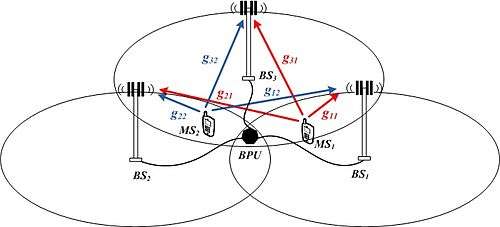Macrodiversity
In the field of wireless communication, macrodiversity[1][2] is a kind of space diversity scheme using several receiver antennas and/or transmitter antennas for transferring the same signal. The distance between the transmitters is much longer than the wavelength, as opposed to microdiversity where the distance is in the order of or shorter than the wavelength.
In a cellular network or a wireless LAN, macro-diversity implies that the antennas are typically situated in different base station sites or access points. Receiver macro-diversity is a form of antenna combining, and requires an infrastructure that mediates the signals from the local antennas or receivers to a central receiver or decoder. Transmitter macro-diversity may be a form of simulcasting, where the same signal is sent from several nodes. If the signals are sent over the same physical channel (e.g. the channel frequency and the spreading sequence), the transmitters are said to form a single frequency network—a term used especially in the broadcasting world.
The aim is to combat fading and to increase the received signal strength and signal quality in exposed positions in between the base stations or access points. Macro diversity may also facilitate efficient broadcasting and multicasting services, where the same frequency channel can be used for all transmitters sending the same information. The diversity scheme may be based on transmitter (downlink) macro-diversity and/or receiver (uplink) macro-diversity.
Examples
- CDMA soft handoff:
- UMTS softer handover.
- OFDM and frequency-domain equalization (FDE) based Single Frequency Networks (SFN) are a form of transmitter macrodiversity used in broadcasting networks such as DVB-T and DAB
- Dynamic Single Frequency Networks (DSFN), where a scheduling scheme adapts the SFN formations dynamically to traffic conditions and/or receiver conditions
- 802.16e macro diversity handover (MDHO)
- 3GPP long term evolution (LTE) multicast-broadcast single frequency network (MBSFN), making it possible to efficiently send the same data to many mobiles in adjacent cells.
- Cooperative diversity, for example 3GPP long term evolution (LTE) coordinated multipoint transmission/reception (CoMP), making it possible to increase the data rate to a mobile situated in the overlap of several base station transmission ranges.
Forms
The baseline form of macrodiversity is called single-user macrodiversity. In this form, single user which may have multiple antennas, communicates with several base stations. Therefore, depending on the spatial degree of freedom (DoF) of the system, user may transmit or receive multiple independent data streams to/from base stations in the same time and frequency resource.
- Single-user macrodiversity
- Uplink macrodiversity
- Downlink macrodiversity
In next more advanced form of macrodiversity, multiple distributed users communicate with multiple distributed base stations in the same time and frequency resource. This form of configuration has been shown to utilize available spatial DoF optimally and thus increasing the cellular system capacity and user capacity considerably.
Mathematical description

The macrodiversity multi-user MIMO uplink communication system considered here consists of distributed single antenna users and distributed single antenna base stations (BS). Following the well established narrow band flat fading MIMO system model, input-output relationship can be given as
where and are the receive and transmit vectors, respectively, and and are the macrodiversity channel matrix and the spatially uncorrelated AWGN noise vector, respectively. The power spectral density of AWGN noise is assumed to be . The th element of , represents the fading coefficient (see Fading) of the th constituent link which in this particular case, is the link between th user and the th base station. In macrodiversity scenario,
- ,
where is called the average link gain giving average link SNR of . The macrodiversity power profile matrix[2] can thus be defined as
The original input-output relationship may be rewritten in terms of the macrodiversity power profile and so-called normalized channel matrix, , as
- .
where is the element-wise square root of , and the operator, , represents Hadamard multiplication (see Hadamard product). The th element of , , satisfies the condition given by
- .
It has been shown that there exists a functional link between the permanent of macrodiversity power profile matrix, and the performance of multi-user macrodiversity systems in fading.[2] Although it appears as if the macrodiversity only manifests itself in the power profile, systems that rely on macrodiversity will typically have other types of transmit power constraints (e.g., each element of has a limited average power) and different sets of coordinating transmitters/receivers when communicating with different users.[4] Note that the input-output relationship above can be easily extended to the case when each transmitter and/or receiver have multiple antennas.
See also
- MIMO
- Antenna diversity
- Diversity schemes
- Diversity combining
- Maximum ratio combining
- Selective combining
- Diversity gain
- Microdiversity
- Many Antennas
- Distributed antenna system
References
- D. Gesbert, S. Hanly, H. Huang, S. Shamai, O. Simeone, W. Yu, Multi-cell MIMO cooperative networks: A new look at interference IEEE Journal on Selected Areas in Communications, vol. 28, no. 9, pp. 1380-1408, Dec. 2010.
- D. A. Basnayaka, P. J. Smith and P. A. Martin, Performance analysis of macrodiversity MIMO systems with MMSE and ZF receivers in flat Rayleigh fading IEEE Transactions on Wireless Communications, vol. 12, no. 5, pp. 2240-2251, May 2013.
- M. K. Karakayali, G. J. Foschini, and R. A. Valenzuela, Network coordination for spectrally efficient communications in cellular systems IEEE Wireless Communication Magazine, vol. 13, no. 4, pp. 56-61, Aug. 2006.
- E. Björnson and E. Jorswieck, Optimal Resource Allocation in Coordinated Multi-Cell Systems, Foundations and Trends in Communications and Information Theory, vol. 9, no. 2-3, pp. 113-381, 2013.